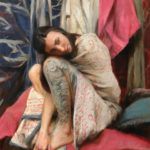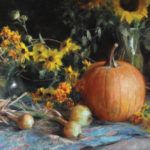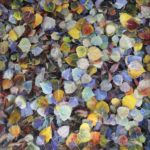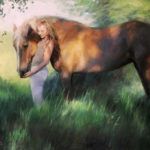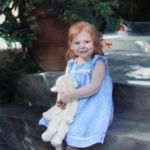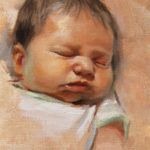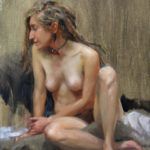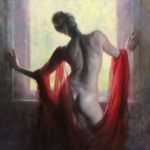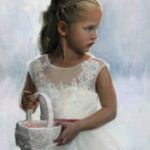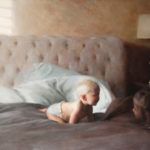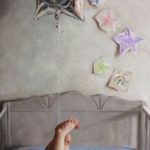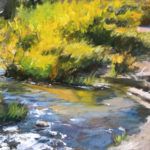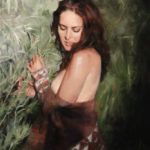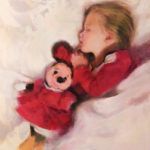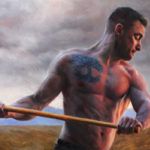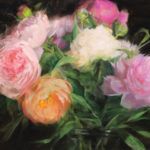Anna Rose Bain paints an array of subjects that inhabit her personal world
By Bonnie Gangelhoff
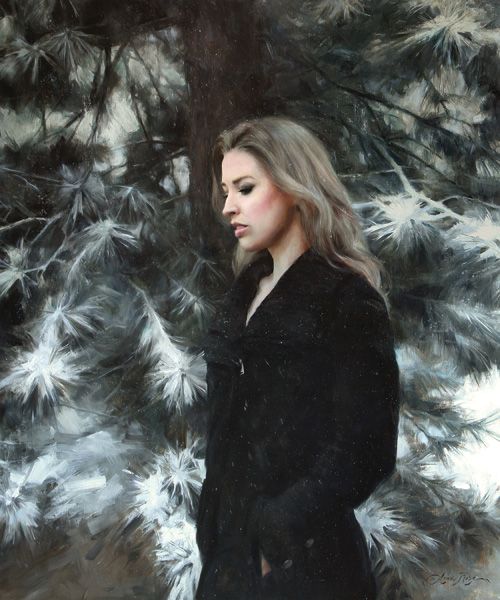
Anna Rose Bain, Silent Snowfall, oil, 36 x 30.
This story was featured in the December 2019/January 2020 issue of Southwest Art magazine. Get the Southwest Art December 2019/January 2020 print issue or digital download now–then subscribe to Southwest Art and never miss another story.
WHEN WINTER arrives and snow falls softly to the ground, Anna Rose Bain is transported back in time to a moment from her childhood. One day when she was about 9 years old, Bain recalls an afternoon spent sledding down hills with her brothers and sisters in rural Wisconsin. As darkness descended, her siblings rushed home for a cup of hot cocoa. Bain, alone in the woods, stretched out on the ground and stared up at the towering pines and oaks. A light powder drifted down to the forest floor, and snowflakes fell on her face and eyelashes. “I remember it being so quiet that I could hear the sound of the flakes hitting the ground,” Bain says. “It was magical, and every time it snows that softly, I am brought back to that moment.”
Bain is reminiscing as she explains the inspiration for her award-winning painting SILENT SNOWFALL. The self-portrait depicts the artist, now 34, standing in profile against a silvery, snow-flecked tree. In 2018 the piece took top honors at the Portrait Society of America’s prestigious annual competition; earlier, it was awarded a gold medal at Oil Painters of America’s Western Regional Exhibition.
- Anna Rose Bain, Calm Amidst Chaos, oil, 20 x 16.
- Anna Rose Bain, Fall Rhythms, oil, 18 x 24.
- Anna Rose Bain, Forest Floor, oil, 24 x 24.
It was just six years ago that Bain was featured in Southwest Art’s annual “21 Under 31” story spotlighting young, up-and-coming talent. She was 28 years old then. Today, Bain is widely recognized for her sensitive and painterly figurative works, often portraying women and children. She is a signature member of the Oil Painters of America as well as a signature faculty member of the Portrait Society of America, and she recently joined noted artist Quang Ho as an instructor in his new online venture, www.madeforartists.net. “It’s basically a Netflix for artists, a streaming service for subscribers to access educational content about art,” Bain says. “I am starting my own channel on there.”
We caught up with Bain at her home in Arvada, a suburb northwest of Denver. Her studio is situated in a 2,800-square-foot walk-out basement. A work in progress sits on an easel in the corner by a north-facing window. The painting features her young daughter dwarfed by a grove of enor-mous trees, with dappled light illuminating the scene. Currently, Bain favors subject matter “close to home”—an artistic focus, she says, similar to that of American realist painter Andrew Wyeth (1917-2009). Indeed, Wyeth was known for his paintings of the land and people in both Chadds Ford, PA, and his summer retreat in Cushing, ME. The artist believed that to best capture a subject, he must know it well. Wyeth depicted one Chadds Ford neighbor, Helga Testorf, more than 200 times. “He painted Helga so many times to capture her in depth,” Bain says. “I can relate to that idea. Each of my paintings is a journal entry for me. Like Wyeth, who painted things he knew, I’m painting my life.”
- Anna Rose Bain, Alix and Stella, oil, 22 x 48.
- Anna Rose Bain, Charlotte, oil, 40 x 30.
- Anna Rose Bain, Everett at 1 Week Old, oil, 6 x 4.
For Bain that means an array of subjects that inhabit her world. In CALM AMIDST CHAOS she depicts a model who poses for her weekly life-drawing sessions, a young woman with a tattoo depicting a Japanese garden design flowing down her left leg. In STRENGTH AND STORM CLOUDS Bain captures her muscular CrossFit coach against a turbulent sky. And in paintings such as MORNING LIGHT, she trains her creative eye on her domestic life, capturing an intimate moment between her young children, Everett and Cecelia. Bain was recently challenged by a “great” artist who suggested that if she wanted to be taken seriously by museums and the “high art” world, she needed to stop focusing on what he called the “sentimental,” meaning motherhood and children. Bain understands that perspective, to an extent, but doesn’t plan to change course. She is grateful to have acquired the wisdom and confidence to follow her own vision when it comes to her art career. “Being in a museum has never been one of my goals,” Bain says. “I’ve always treated my art like a diary, and I don’t know how to do it any other way.”
BAIN WAS born in 1985 and grew up in Mauston, WI, a small town known for its apple orchards and dairy farms. Bain’s father worked in law enforcement and her mother, a former nurse, raised and homeschooled her six children. Her parents believed that an art and cultural education were essential components in their children’s curriculum. As a youngster Bain studied classical piano; when she was 10 and showed an interest in painting, her grandfather, who had taken up art late in life, shared his knowledge and his brushes with her. “I remember feeling so privileged,” she says.
- Anna Rose Bain, Felissia Seated, oil, 16 x 12.
- Anna Rose Bain, Figure in Red, oil, 30 x 30.
- Anna Rose Bain, Flower Girl, oil, 24 x 18.
Bain’s father purchased subscriptions to art magazines for her, and she pored over art books checked out from the local library. By the time she enrolled in Hillsdale College in Michigan, there was little doubt about her major. Although she was an accomplished pianist by then, she chose the visual arts, graduating in 2007 with a degree in fine art and a minor in music.
In the summer between her junior and senior years, the college awarded her a scholarship that allowed her to study classical realism at the Florence Academy of Art in Italy. The experience marked a major turning point in her art journey. “I got hooked on figurative painting,” she says. “We spent four weeks studying, drawing, and painting from a live model in one simple standing pose, and for the first time I began learning how to truly see and understand skin tones. Under those subtle north-light skylights, I learned that the skin changes in color temperature ever so slightly as it turns toward or away from the light. These transitional areas are captivating to me because just the slightest shift from warm to cool, or vice versa, can create the illusion of translucency.”
- Anna Rose Bain, Morning Light, oil, 18 x 36.
- Anna Rose Bain, Reach, oil/silver leaf, 48 x 24.
- Anna Rose Bain, Shallow Stream, oil, 9 x 12.
Bain says the revelation was not only that value describes form but also that she could “turn” form just as effectively with color temperature. This concept has played a central role in her mastery of depicting the faces of infants, young children, and other figurative subjects in almost any type of lighting situation.
In the years since college, Bain has studied with a long list of master artists, including Nancy Guzik, Daniel Sprick, Quang Ho, and Richard Schmid. From time to time, she hears Schmid’s words of advice echo in her head: “It doesn’t have to look like anything; it just has to look good.” These days Bain describes her style as realism, ranging from tighter to looser depending on the subject. “I used to want to idealize a subject, but now I want to paint with honesty and authenticity,” she says. “Life is messy.”
ONE SATURDAY recently, Bain was alone in her studio and feeling excited because her husband, Steve, had taken the children to the Denver Zoo. For Bain, that meant five uninterrupted hours to paint. The day before, her studio session had totaled just 30 minutes. As a mom with two small children and a passion for painting, Bain is learning patience. “My painting time is limited, and I don’t want to squander it on easy things,” she says. “I’m learning to be more comfortable with being uncomfortable. I am taking on subjects that I consider to be so challenging that they are almost unpaintable with my skill set.”
- Anna Rose Bain, Sunbathed, oil, 18 x 14.
- Anna Rose Bain, Sweet Dreams, oil, 14 x 11.
- Anna Rose Bain, Strength and Storm Clouds, oil, 24 x 36.
Bain is pursuing challenges, in part, by going back to her rural roots where, as a child, she had a tremendous love for horses, wildlife, flowers, and trees. Thus, these subjects are now emerging in her body of works. While Bain is primarily a figurative painter, still lifes and landscapes pro-vide a break from the intensity of painting the human face and figure. And for her, the genres also offer the opportunity to work on developing a stronger sense of design. In FOREST FLOOR, for example, she explores the design concept of equalization: “The idea is that everything has its place, all elements being equal and not standing out,” she says. “I found the process to be extremely therapeutic and good for my mind. I was constantly stepping back, squinting, and analyzing it in a thumbnail version to see what I could strengthen in the composition.”
In WHITE, PINK, AND CORAL PEONIES Bain took on the challenge of creating motion and rhythm in her composition and brushwork. Her goal was to have the still life read almost like a piece of sheet music, flowing from one side to the other. Like Wyeth, Bain admits she has her own obsessions, and painting peonies is one of them. Every June, she drops everything to portray her favorite flower, in a yearly routine she calls her “peony-painting frenzy.”
Bain isn’t sure how the peony obsession began but suspects it may have started with choosing the flowers for her wedding. These days, though, there’s a deeper meaning behind it. Centuries ago, flowers in art represented life’s transience in a still-life genre known as vanitas. “At some point, each of us has to face our own impermanence,” Bain says. “In their prime, peonies take center stage with their dinner-plate-size blooms and intensity of color, but their season is so short. They remind me that my moment on earth is a short blip in the timeline of eternity, and I must bloom as brilliantly as I can before my little life is extinguished.”
representation
Saks Galleries, Denver, CO; John C. Doyle Art Gallery, Charleston, SC.
- Anna Rose Bain, White, Pink, and Coral Peonies, oil, 12 x 24.
This story was featured in the December 2019/January 2020 issue of Southwest Art magazine. Get the Southwest Art December 2019/January 2020 print issue or digital download now–then subscribe to Southwest Art and never miss another story.
MORE RESOURCES FOR ART COLLECTORS & ENTHUSIASTS
• Subscribe to Southwest Art magazine
• Learn how to paint & how to draw with downloads, books, videos & more from North Light Shop
• Sign up for your Southwest Art email newsletter & download a FREE ebook






